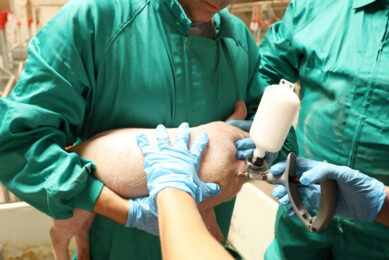PCV2 vaccination changing the pig industry

Part 3. Reduced antibiotic usage and improved performance go together
©
Vaccinating against Porcine Circovirus 2 (PCV2) does not only save lives at pig production sites, it appears to have beneficial effects in reduction of the use of antimicrobials. A couple of farm examples can illustrate how.
©
By Frances Glass, Animal Information Network, UK
©
Possible health strategies to reduce the use of antimicrobial drugs at farm level have become of great interest because of the continuous heavy pressure on producers of food animals from consumer groups, retailers and regulators. For pig farms, international evidence has shown that vaccinating against Porcine Circovirus, type 2 (PCV2) should be included as an important part of any proposed strategy.
The message from field studies and from practice is clear. Circovirus vaccination is a tool available to pig producers for reducing the total antimicrobial usage on their farm. Veterinary specialists advise that this effect is most probably due to the reduction in concurrent infections which occurs on farms where PCV2 vaccination is applied.
©
Major markets already vaccinate against PCV2 as a standard procedure. As more producers adopt the vaccination,
its success in reducing the total amount of antimicrobials while maintaining animal health and the profitability of production will project an improved image for pork production. Vaccinating therefore emerges as an good investment, both for the farm and for the industry.
©
Experiences
Some of the most compelling recent evidence on this point relates to the experiences of commercial farms after they started PCV2 vaccination. Reports of several examples have been presented to recent international congresses with regard to pig farms using the PCV2 vaccine Ingelvac Circoflex, produced and marketed by Boehringer Ingelheim.
Each of the case histories has confirmed that the vaccinated pigs grew well, with reduced amounts of antimicrobials needed, and they provided a greater return on investment to their producers.
©
Experiences in Canada
This has even been the case in a high-health sow herd in Canada achieving almost 28 pigs weaned per sow per year, according to a retrospective review by Brockhoff and others in 2009. The investigation looked at the production results and data on antibiotic use at this herd of 2,800 sows and its associated three-site production system in Western Canada, during a period from April 2007 until March 2009.
Throughout this time, the herd tested negative for PRRS virus and for Mycoplasma hyopneumoniae. Initially, its operators also did not regard circovirus disease as a primary health concern at the complex. But in May 2008 they went ahead with a procedure of giving a single dose of the PCV2 vaccine to pigs on weaning at 20 days old, while leaving the sows and gilts unvaccinated.
The Canadian team analysed data for six wean-to-market production batches before the start of PCV2 vaccination and another six batches that had been vaccinated. Their analysis revealed an increase in the average daily liveweight gain from 845 grammes to 913 grammes while the mortality rate was cut by more than half, from an average of 5.4% to just 2.1%. Vaccination, they decided, had also significantly reduced the overall culling rate of pigs between weaning and market weight, from 6.6% down to 2.7%.
©
However, probably the most notable comment from the reviewers was in reference to medication use and costs at the production complex. They said that the reductions in mortality rate and in the premature removal of animals, added to other improvements in performance and productivity seen following vaccination, translated for this farm into better herd health and a decrease in overall medication usage. By extension, this resulted in a lower cost for antibiotics and treatments for the entire system.
Figure 1 shows the marked reduction found in the use of medication by the year in quarters. This declining trend was mirrored in usage charts for medications given in feed or water or by injection.
©
At the same time as the improved production parameters were observed in the production system, antibiotic costs per pig dropped from CAD$1.20 (US$1.16) to CAD$0.42 (US$0.40) as a direct reflection of reduced and more prudent use. Overall, the six production batches that received PCV2 vaccination had a yearly return of CAD$6.60 (US$6.43) for each CAD$1 (US$0.98) invested in vaccine.
In another example from Canada, seven finishing units of a Canadian pork company recorded a lower antibiotic usage and improved pig performance after adopting PCV2 vaccination – this was described last year by S. Lapierre and others. Table 1 shows how the results for each finishing unit changed after implementing the vaccine regime.
The piglets received the single-shot vaccination at weaning. Because these pigs originated from the same sow herds and were otherwise exposed to similar conditions, the author concluded that any changes in medication and performance would be due mostly to the vaccination protocol.
©
©
From the comparison in Table 1, vaccination brought improvements for daily weight gain and for the feed conversion ratio. The mortality rate in vaccinated pigs was reduced to 4.6%, compared with a figure of 9.5% before vaccination. As for the average cost of antibiotics per pig, this decreased from CAD$3.86 (US$3.72) to CAD$2.37 (US$2.28).
©
Experiences in Japan
An equally dramatic contrast between production parameters and economics before and after vaccination has been found at a commercial farm of 200 sows in Japan as described in research by Yako, in 2009.
It started vaccinating in April 2008, for pigs three weeks old. A comparison afterwards of its results in financial years 2007 and 2008 revealed that annual medication costs at the farm had decreased by 620,450 yen (almost €5,000) because of less use of antibiotic treatments. Data starting from September 2008 also showed a reduction of 5.7 days in the average time taken to reach market weight and the carcass weight increased by 2.4 kg per pig. Major reductions in the number of lightweight pigs marketed and in dead pigs made a significant further contribution to profitability.
©
Experiences in the UK
Similarly, the introduction of vaccination against PCV2 reduced antibiotic use as well as improving mortality and performance in pigs sourced from a 900-sow herd in England, as was shown by Brons and others in 2009. The herd introduced routine PCV2 vaccination in May 2008 for pigs weaned at 28 days of age. Before then, it was already using a Mycoplasma hyopneumoniae vaccine at weaning and since early 2007 had been vaccinating sows to control PRRS.
Performance between weaning and slaughter was checked for five grow-out sites that received weaned pigs from the herd. Running from November 2007 to February 2009, the data covered a total of 11 batches. Seven of these batches were after the start of PCV2 vaccination.
Table 2 shows the performance comparison for successive batches, including a statistically significant decline in the average mortality rate per batch from 6.4% to 2.8%. The batch to batch variation in mortality was also reduced. With the average daily liveweight gain increasing from 669 g to 729 g, the feed conversion ratio improved from 2.53 to 2.44.
©
Results in the grow-out unit that was already achieving top performance showed a reduction in mortality of 25% (3.1% to 2.3%), growth rate increased from 725 g to 761 g and the feed conversion ratio reduced from 2.43 to 2.37. The total veterinary costs (visit fees and all antibiotics) was reduced from £1.62 (€1.84) to £1.26 (€1.43), a reduction of over 22%.
©
The herd being examined was one of 28 breeding units belonging to a British enterprise with a total of 26,000 sows. This examination analysed the reduction in overall medication costs for all the pigs reared in the company in 2007 compared to 2008, following the introduction of PCV2-vaccination. It concluded that, in the whole system (560,000 pigs slaughtered, from 28 breeding units), antibiotic costs in 2008 where reduced by 27% compared to 2007.
Including the additional investment in vaccines, the total expenditure on all medicines (antibiotics and vaccines) given to rearing pigs from 2007 to 2008 reduced by 4.2%.
©
Experiences in South Korea
PCV2 vaccination on a Korean farrow to finish farm of 250 sows succeeded in reducing the medication cost from 8 million won (€5,200) to 2.5 million won (€1,600) per month, a case study by Jung in 2009 has reported. Before vaccination use was introduced, the farm had suffered from circovirus disease effects including a wean-to-finish mortality rate that was about 15% on average and reached a peak of more than 26% in March 2008.
Vaccination started one month later. Data from September 2008 to May 2009 recorded by the farm’s owner showed the mortality rate ranging only between 2.8% and 7.3%. There were also few respiratory problems and diarrhoea requiring treatment, which accounted for the sharp fall in medication costs.
©
Experiences in Thailand
Stunted growth and other clinical signs affected pigs about 12-14 weeks old, on a farm in Thailand that moved them at the age of ten weeks from the breeding site to a separate finishing unit, as was reported by Duangwhae and others, last year. The farm was positive for PCV2 and for M. hyo. However, the losses rate was cut by more than half once the weaned pigs started receiving vaccination. Daily gain, feed intake and feed conversion ratio figures also improved. Even better for the farm’s bottom line, its medication cost per pig fell after vaccination by nearly 41%.
Given the evidence from each of these testimonials, some remarks by Canadian veterinary experts at a recent scientific congress should come as no surprise. They declared that the use of timed vaccination as a biological tool to assist in preventing specific diseases is a valid animal health management strategy which also minimises on-farm antimicrobial usage. Through proper application, they insisted, vaccination can play a vital role in the reduction of antibiotic use without compromising animal welfare and operational productivity. Working together, farmers and veterinarians can meet consumer and marketplace demands for high quality pork while maintaining productivity for the swine producer. PP
Given the evidence from each of these testimonials, some remarks by Canadian veterinary experts at a recent scientific congress should come as no surprise. They declared that the use of timed vaccination as a biological tool to assist in preventing specific diseases is a valid animal health management strategy which also minimises on-farm antimicrobial usage. Through proper application, they insisted, vaccination can play a vital role in the reduction of antibiotic use without compromising animal welfare and operational productivity. Working together, farmers and veterinarians can meet consumer and marketplace demands for high quality pork while maintaining productivity for the swine producer. PP
©
References available on request.
©
********PLEASE©CLICK©HERE©FOR©PDF©VERSION©OF©THIS©ARTICLE
©
Source: Pig Progress magazine Volume 26.2











